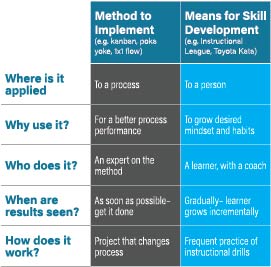Next Step in Lean Manufacturing – Kata
Critical-Thinking to Expand Continuous Improvement
“Why is our lead time so long?”
If you’ve asked this question on the shop floor, more than likely you were met with blank stares by your employees. Open-ended questions like this are overwhelming, so employees try to find quick answers that don’t address the problem. They don’t have a starting point to form an answer. But what if you asked a question with a specific, achievable goal?

“What steps can we take to reduce lead time by 3 days?”
You’ve then provided your employees with a measurable goal in the form of a question. Your workers may feel empowered to answer with some hands-on suggestions for incremental changes, such as reducing setup steps or combining workstations. This, in turn, could not only reduce lead time but significantly eliminate wait times and inventories.
This approach is often described as Kaizen, or “continuous improvement,” which serves as the backbone for lean manufacturing. Kaizen uses the Plan, Do, Check, Act (PDCA) problem-solving cycle to encourage manufacturers to use small ideas to solve big problems, such as costly, time-intensive changeovers.
These methodologies are the building blocks of Kata, an innovative, lean way of thinking described in the book by Mike Rother, Toyota Kata: Managing People for Improvement, Adaptiveness, and Superior Results.

Like previous approaches to Lean, Kata seeks to enable organizations to gain and sustain competitive advantage through a cultural aptitude for process improvement. Kata is built on many of the principles and concepts that have been central to Lean for decades.
You may be thinking – “I thought that is what lean manufacturing and Kaizen was” – and you are partly correct. The difference between Kaizen and Kata is that Kata involves a mental approach focusing on critical thinking and problem-solving skills as opposed to physical changes in the environment. Anyone with a lean background has learned that Kaizen is loosely translated as “change for the good”. Complementary to that is Kata – “small routines that allow us to continually improve”. Kata is the continuous improvement aspect of Lean Manufacturing.
The Difference Between Lean Manufacturing Approaches and Kata:
With manufacturing evolving at an incredible pace thanks to developments such as Artificial Intelligence (AI), labor skill gaps, and the Industrial Internet of Things (IIoT), Kata gives manufacturers a lean strategy to help them grow with these developments. It empowers employees with the skills they can use to continuously improve, adapt, and generate ideas for a strategic, competitive advantage.

How many of you have gone through lean training, maybe done some value stream mapping, some 5S, and Kaizen events? How well have you sustained the gains from lean? Maintaining lean tools and techniques may be difficult. Managing for Daily Improvement (MDI) is the missing link in lean culture transformation efforts. While Kaizen events and continuous improvement projects provide breakthrough results, these are often not sustained. The key to sustainment, as well as 100 percent involvement, resides in the power of MDI.
THE POWER OF DAILY TEAM HUDDLES:
- Using a “Business Status Sheet” to drive daily improvement
- Leader standard work to create accountability within the team structure
- Problem-solving thinking; how to align your organization so that the right problems are solved at the right level
MDI is by far the most important tool that drives accountability and problem-solving minute-by-minute, hour-by-hour, and day-by-day.
Teamwork is critical as are the daily huddles.
Small Steps Lead to Big Results for Manufacturers
Toyota is known as the most successful early adopter of Kaizen and the originator of the “continuous improvement” philosophy for manufacturers as part of its innovative Toyota Production System. This approach helped the company create vehicles famous for their reliability while eliminating production waste, time, and energy resources. Toyota’s “plan slowly and act quickly” philosophy helped create the Prius hybrid, which positioned the company as the leader in hybrid technology. More than 80 years after the company’s founding, Toyota is the world’s largest automaker.
Kata builds on Toyota’s “continuous improvement” success model, so other manufacturers can learn from its example. This approach has become increasingly popular with manufacturers who want to move beyond short-term production goals to empower their workforce to implement daily, sustainable process improvements.
How to Integrate Kata Within Your Facility
By integrating Kata as part of your manufacturing best practices, your employees can successfully overcome obstacles and develop more confidence and systematic thinking to solve problems.
While smaller manufacturers may not have the level of strategic resources like Toyota, they can apply the same methodologies of Kata, including:
- Developing new habits and allowing people to think differently about problems and goals
- A way of working, and of working together
- Using scientific thinking as an ingredient to make teams and organizations more effective and successful
- Developing a culture of continuous learning and improvement at all levels through deliberate practice
Implementation of Kata begins with Starter Kata. Starter Kata focuses on small protocols and processes that, when practiced early and often, help manufacturing employees learn faster and teaches them to work more collaboratively. The two main elements of Starter Kata are Improvement Kata and Coaching Kata.
The Improvement Kata & Coaching Kata don’t just model a way of working, they also include structured practice routines to make their pattern teachable and transferable. This is a way to build improvement capability into an
organization and make effective empowerment possible.
The Improvement and Coaching Kata help employees:
- Understand the direction or challenge
- Grasp the current condition
- Establish the next target condition
- Experiment toward the target condition
By integrating Kata as part of your manufacturing best practices, your employees can successfully overcome obstacles and develop more confidence and scientific thinking to solve problems.
Advice on Starting Kata
Here is some advice on how you can achieve a successful Toyota Kata deployment:
- Find processes that look like good practice fields, where the improvement challenges are meaningful to participants and the Process Analysis Kata is straightforward to apply, so learners are likely to enjoy success from their early efforts.
- Communicate openly with coaches and learners this is about building their skills and shifting their mindsets, and they will be asked to persevere through initial awkwardness and ineptitude—as is normal in skill-building. Remember: People seem most willing to try new things when senior leaders go first.
- For participants whose managers are not directly involved in Kata practice, ensure those managers understand the skill development approach and agree to support it.
- Ensure participants have a solid baseline awareness of Kata’s intent and mechanics before starting practice, so correct practice of the routines will be possible.
- Establish coach-learner relationships where mistakes can be made safely and corrective feedback will be valued.
- Don’t ask people to practice where effective coaching is unavailable, because then people naturally just practice their existing habits.
- Find a way to ensure practice sessions are happening frequently—ideally daily—and that the improvement and coaching skill patterns are being practiced correctly.
- Gauge whether proficiency with these skills is growing by watching the degree of actual process improvement, then adapt accordingly.
What is Kata in Lean?
Kata is not a replacement for Lean tools and techniques. The Kata model builds systematic thinking skills that, when practiced, will make the learner a better problem-solver.
Kata develops new skills
A “Kata” is a set of practices that help develop a new habit or skill. A Kata Learner works through a set of practice routines and reviews with a Kata Coach what has been done, what has been learned, and what are the next steps.
Throughout the process, small, incremental changes are made and tested and learning incorporated in working toward the larger vision or challenge. This practice is most commonly discussed as kata in martial arts (the term “kata” is of Japanese origin) but is easily observed in many sports, music, and other areas where a “learner” works with a “coach” to improve a skill.
Kata supports Lean
In the world of Lean, the Improvement Kata and the Coaching Kata combine to form a similarly powerful method for building the skills of problem-solving.
Kata doesn’t compete with Lean tools and techniques such as:
A3 – The process is a simple way of getting a problem, an analysis, a corrective action or an action plan written down on a single sheet of large paper.
Value Stream Mapping – A lean technique used to track the flow of materials and/or information required to deliver a product to the end customer.
5S – A lean manufacturing tool often used at the start of a lean manufacturing improvement process to optimize the workplace and ensure a safe working environment. 5S provides a solid foundation on which a lean manufacturing process can be built.
Total Productive Maintenance – A system of ensuring ‘zero-downtime’ of equipment, emphasizing production operator involvement in equipment maintenance.
Standard Work – A definition of the most efficient methods for producing a product using the available equipment, materials, and people.
Kanban – A process of continuous supply of parts and supplies so that operatives have what they need when they need it.
and so on…
It is a way of training and supporting the members of an organization in approaching problem-solving using scientific thinking. As such, Kata can be applied to increase the effectiveness of any Lean tool or technique by grounding it in logical, systematic thinking that delivers rational, provable results.
Approaching problems in business scientifically allows us to come to well-reasoned, logical solutions and discuss them effectively with others by being able to demonstrate precisely how the solutions were tested and evaluated again relevant criteria.
